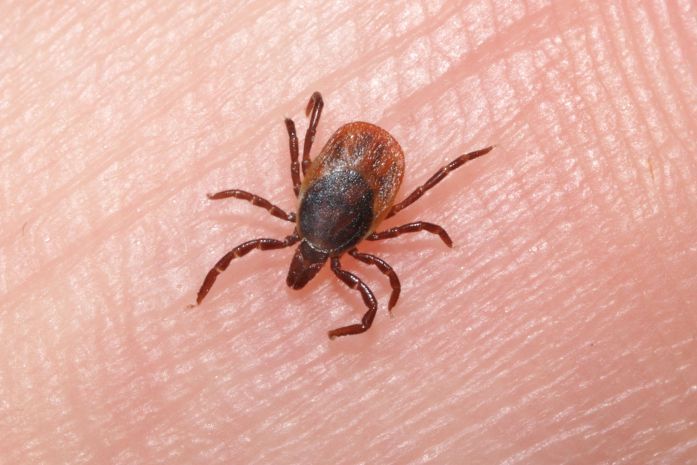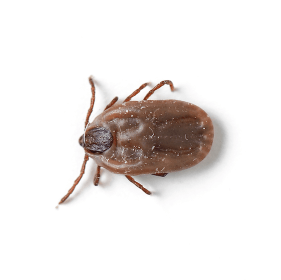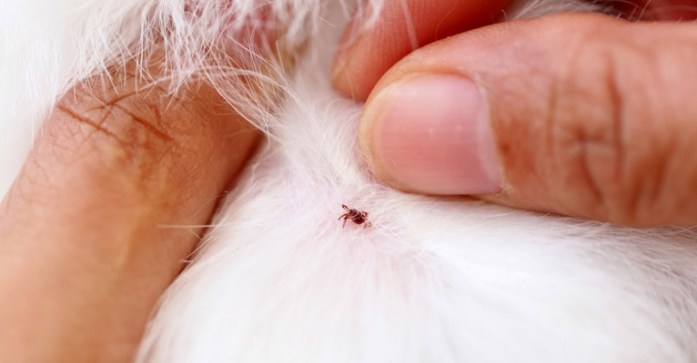Seeing your dog happily running through the fresh, green grass might sound very appealing. However, doing so can also lead to serious tick infections and tick-borne diseases! Ticks on dogs can be a nightmare for many owners. Hard to spot, these small creatures are not only tricky to remove, they can also lead to major infestations in homes.
In this article, we will discuss more about ticks on dogs, including the various tick-borne diseases, how to remove ticks as well as how to prevent them from getting on your dog!
What Are Ticks?

Ticks are small parasites that are a type of arachnid, which means that they belong in the same family as other pests such as spiders or mites. These parasites generally thrive in warm, humid climates like Singapore.
Ticks survive by feeding on the blood of animals, including both pets and humans. As they suck in more blood, these blood-sucking organisms also grow in size. After a period of time, they detach from the host’s body when they are full to molt or lay eggs (for adult female ticks), which might then lead to tick infestations.

There are as many as 850 species of ticks around the world. However, the most common tick in Singapore is the brown dog tick. Usually reddish brown, these ticks become gray-blue when full of blood. They are also oval in shape, and are typically 3mm to 12mm in size.
Ticks On Dogs

As ticks generally prey on unsuspecting animals running through vegetation in the wild, dogs are one of the most susceptible victims of ticks. In addition, once brought into homes, they can also survive well and breed indoors, making them difficult to deal with.
When a tick latches on to your dog, it typically finds itself a warm, moist spot (like the head, neck, ears and feet). Covered in hooks, the tick’s mouth then digs into the skin, allowing it to stay attached, sucking blood for days.
After the tick has detached from the body, the site of the bite might then become red, inflamed or itchy. This can then cause skin irritation and constant scratching, which may result in bacterial infections as well as hair loss.
Ticks are also able to transfer parasites from one animal to another — making them great carriers of many dangerous tick-borne diseases.
Tick-Borne Diseases

Please consult your vet immediately if your dog has had an episode with ticks and is showing the any of the following symptoms of tick-borne diseases below.
Canine Babesiosis
One of the more common tick-borne diseases in Singapore, canine babesiosis is caused by the babesia parasite that is transmitted via ticks. As this parasite infects the red blood cells, it can cause anemia when the body’s immune system destroys these infected blood cells. In addition, the babesia parasite can also damage multiple organs and cause dogs to go into shock.
Symptoms include unusually dark urine, fever, lethargy, pale gums and tongue, swollen lymph nodes as well as jaundice (yellowish skin, gums and eyes). Although it can be treated, some dogs might still never entirely recover from an infection. This is because dogs that have previously suffered from bebsiosis are still susceptible to experiencing another relapse of the disease.
Canine Ehrlichiosis
Another common disease here in Singapore, canine ehrlichiosis is caused by the ehrlichia bacteria. Affecting the white blood cells, ehrlichiosis can also cause anemia in dogs.
Symptoms include fever, lethargy, loss of appetite, weight loss, abnormal bleeding, coughing, vomiting, diarrhea, neurological symptoms and swollen lymph nodes. In some cases, it can also lead to organ damage such as kidney disease.
Rocky Mountain Spotted Fever (RMSF)
More commonly found in Canada or the USA, RMSF is caused by the bacteria R. rickettsii. If your dog is down with RMSF, they might display symptoms such as poor appetite, joint or muscle pain, fever, coughing, abdominal pain, vomiting, diarrhea and depression.
Lyme Disease
Lyme disease is caused by the bacteria B. burgdorferi, and generally spread by infected blacklegged or deer ticks. These ticks are not found here in Singapore, thus lyme disease is fairly uncommon. Symptoms of lyme disease include fever, loss of appetite, lack of energy, lameness, swollen joints as well as general stiffness, discomfort or pain.
Removing Ticks On Dogs

It is advised to remove the ticks on dogs as soon as possible. However, when removing ticks, pet owners need to be careful to try to completely remove the head of the tick and not to squeeze the tick’s body. This is because squeezing the body might cause the tick to expel blood back into your dog, increasing the risk of infection.
- Grab a pair of fine-point tweezers.
- Spread your dog’s fur to expose the tick.
- Use the tweezers to grab the tick as close to the skin as possible.
- Gently pull upwards slowly until the tick detaches (do not use sudden, forceful movements, as it might not completely remove the tick and leave the head in).
- Disinfect the area.
- Wash your hands after. Make sure not to touch any ticks with your bare hands.
If you face trouble removing ticks on your own, you can also consult your vet or groomer.
Preventing Ticks On Dogs

1. Avoid Grassy Areas
Whenever possible, avoid walking through grassy areas and vegetation, which are more likely to have mites. Walking through the park using roads, walkways, pavements or gravel are better and safer choices for your dog.
2. Check Your Dog After Walks
If your dog loves the grass, routinely checking for fleas and ticks is a great way to prevent infestations. Combing and washing your dog with a flea and tick shampoo after is also highly recommended.
3. Housekeeping
Regular cleaning, vacuuming and washing of bedding can also help prevent future infestations. Moreover, if you have a garden, consider trimming the grass to help reduce the likelihood of ticks being present.
If your home is infested, you might want to call pest control or try your hand at getting rid of the ticks yourself by using products such as powders, sprays and foggers that are designed to kill ticks.
4. Treat & Prevent Ticks On Dogs With Tick Products
Spot-ons such as Frontline Plus are the most commonly used method in Singapore to help prevent fleas and ticks on dogs. Used in most shelters, this spot-on contains pet-safe insecticide which helps coat your dog’s fur after application, killing ticks as well as fleas upon contact in roughly 30 minutes.
Chewable tablets like Nexgard Chews can also be given to your dog to help treat and prevent ticks. From the same makers as Frontline, these beef-flavoured tablets are palatable and easy to chew, making it another popular choice among pet owners.
Before giving any medication, do consult your vet to ensure your dog is fit for consumption.
When dealing with ticks, prevention is key. Be extra cautious when bringing your dog through grassy, woody areas. In addition, do take note to be careful when dealing with ticks yourself! Although the brown dog ticks in Singapore do not transmit diseases to humans, ticks can still feed on human blood.
If you would like to read more about fleas and ticks, do check out ‘How To Prevent & Treat Flea, Ticks, & Other Parasite Infestations in Cats and Dogs’.










